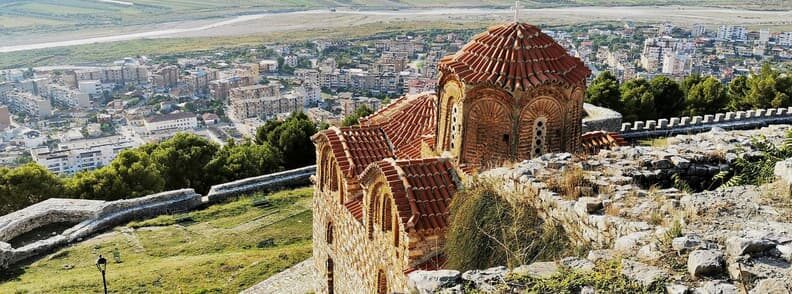Berati or Berat Albania is one of the oldest and most beautiful cities in the Balkans. The panorama of its white cottages descending the mountain to the citadel is one of the country’s most iconic sights. The fortress walls enclose the whole summit of the hill. There are eight medieval churches inside, one of which has an exceptional collection of icons painted by the 16th-century artist Onufri.
Berat Albania also contains an excellent Ethnographic Museum and a number of other significant structures, including two of Albania’s oldest mosques.
Disclosure: Some of the links below are affiliate links. This means that at no extra cost to you, The Travel Bunny will earn a small commission if you click through and make a purchase. Thank you!
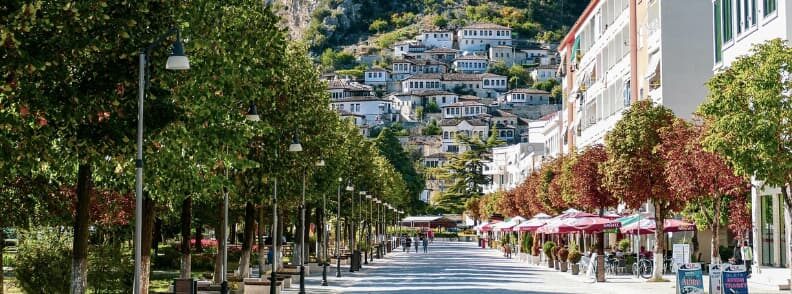
Short Berati history
Berat Albania has been inhabited since the Bronze Age. The vast Tomorri massif beyond it has long been revered as a sacred mountain, and it still hosts a massive Bektashi festival every August. The first evidence of the construction of the citadel dates back to the second half of the 4th century BC when the Illyrian Parthini ruled the region.
Berati flourished in the Middle Ages because of its advantageous location at the crossroads of trade routes from the south and the lowland plain. This made it a tempting conquest for subsequent invaders. The Bulgarian Empire captured the city in AD860 and held it until 1018, with the exception of a 40-year interval when it was reconquered by Byzantium. Despite a vigorous invasion by the Angevins, who besieged the fortress for seven months in 1280-81, Berati’s second return to the Byzantine fold lasted longer. However, when Byzantium’s authority fell in the mid-14th century, Berati and much of the rest of Albania became part of Stefan Dušan’s ‘Empire of the Serbs and the Greeks.’
Following Stefan Dušan’s death in 1355, the Muzakaj family of Berat Albania took control of the southern region stretching as far as Kastoria (today in northern Greece), one of the major Albanian clans that emerged as the sole functional authority prior to the Ottoman invasion. The Ottomans captured Berati’s castle in 1417, and despite an effort to recover it led by Skanderbeg in 1455, it remained in their hands for nearly 500 years.
During World War II, the mountains of the Berati area were a hotbed of partisan activity, and the city was the first headquarters of the Interim Government, which came to power in October 1944 under the leadership of Enver Hoxha.
The name of the city may arise from the Turkish term berat, which means an order bestowing a decoration, a kind of royal warrant. Alternatively, it may derive from Beligrad, the name given to the town by the Slavs, but this is debatable from a philological standpoint.
In July 2008, Berat Albania was designated as a UNESCO World Heritage Site.
Best places to see when you visit Berat Albania
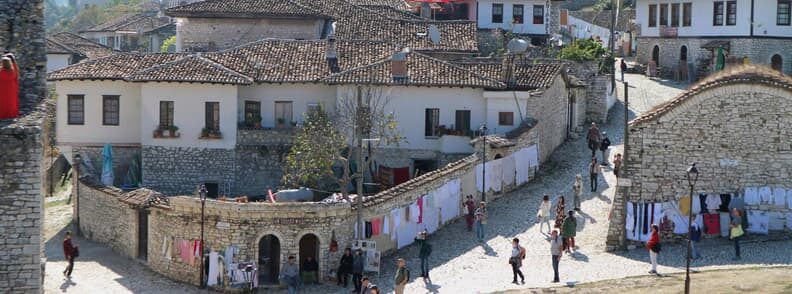
1. Berati Castle
The Illyrian Parthini fortified Berati’s castle in the fourth century BC. They simultaneously fortified the opposite hill from the left shore of the Osumi River; the ruins of Gorica Castle may still be admired amid the woods. The two fortifications ensured control and defense of the whole valley of the river.
The simplest way to reach Berati Castle is to go uphill on Rruga Mihal Komneno (Rruga e Kalasë or Castle Street) – the steep cobblestone road that runs through the Mangalemi historic neighborhood. While you can drive on this route, it’s preferable to take the long road around the back of the hill on which the castle lies. There are several quick ways up the twisting stone staircases via Mangalemi and then through the forests below the castle on foot, but without a guide, it is impossible to discover the right paths.
A cross with the initials MK can be seen on the wall near the archway that serves as the castle’s exterior entrance. This is most likely the result of a refortification of the citadel in the 13th century, under the reign of Michael II Comnenus Ducas, Despot of Epirus. The walls form a rough triangle that follows the slope of the hilltop, and a network of small cobbled alleys joins the stone-built homes within them. Many families still live in the citadel, with the more entrepreneurial running souvenir shops, guesthouses, or cafés.
Only eight of the 42 churches that originally stood within the castle walls survive to this day. They were closed up during the late 1960s atheism campaign except for one. That exception was the Church of the Dormition of St Mary, a three-naved basilica erected on top of the ruins of a 10th-century church. It now houses the Onufri Museum.
Onufri Museum
Onufri was the greatest of a series of unnamed Albanian icon-painters who flourished in the 16th century. He created icons across the Balkans, but many of his best were produced for the churches of Berati fortress. Onufri followed and expanded Byzantine icon-painting traditions, but his work is notable for his command of color; the red paint he employed is known as Onufri Red.
The Onufri Museum was completely renovated in 2016, and the display now spans two floors. There are almost a hundred gorgeous icons on exhibit from churches in Berat Albania and the surrounding region. The first is from the 14th century before any icon painters started to sign their work.
Apart from Onufri, later artists whose names we know include his son Nikolla, David Selenica, Kostandin Shpataraku, and the Katro or Çetiri family from Korça. Some of the icons blend conventional Byzantine iconography with Ottoman motifs, such as a circular table, the sofër at the Ethnographic Museum, in an icon of The Last Supper, and mosque minarets peering over the city walls in the icon named The Life-Giving Source.
Liturgical artifacts like as crucifixes and Bible covers are also included, as are samples of the magnificent work of Berati’s silver and goldsmiths.
The museum is entered through the church, which is well worth seeing. Master artisans from the Berati School of the nineteenth century sculpted the magnificent iconostasis at the far end in walnut wood and adorned it with gold leaf. The three major icons were created by Onufri and installed in the church when it was completed. Others were created by Johan Katro in the mid-nineteenth century. The two manuscripts known as The Codices of Berat were discovered in 1968, buried below the altar – the 6th-century Purple Codex is one of the earliest such manuscripts ever unearthed anywhere – and are currently kept in Tirana’s State Archive.
A trip around the perimeter walls to the lookout will give you a sense of the castle’s scale and layout, as well as wonderful views of the city below and the mountains across the river.
Saint Michael’s Church
The 13th-century St Michael’s Church nestles into the slope below and can be seen well from the Gorica area across the river. From the main road, a trail runs up to this church. You can skip the hazardous walk as this church is normally closed to visitors.
Saint George’s Church
Above the Belvedere point, just inside the fortifications, you’ll find the 14th-century Church of St George, which was transformed into a restaurant during the communist era but has since been rebuilt by parishioners.
Saint Mary of Blachernae Church
The oldest church in the fortress is St. Mary of Blachernae, which was erected to commemorate the defeat of the Angevin besiegers in 1281, according to local legend. The inscription on the narthex door indicates that it was renovated in 1578, and the paintings were painted by Nikolla, Onufri’s son.
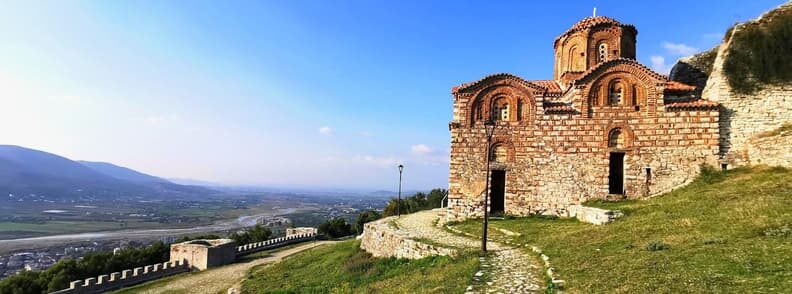
Holy Trinity Church
The Holy Trinity Church may now be seen on the slope of the hill right below the castle’s inner fortifications. This section of the castle was constructed about the same time as the church, in the 13th century.
The Red and White Mosques
The Ottomans conquered Berati in 1417, and the victors lost no time in reinforcing the castle. They also constructed two mosques:
- The Red Mosque, which was heavily damaged by German bombings during WWII, sits immediately outside this region.
- The White Mosque, so-called because of the exquisite white stone from which it was constructed, lies at the inner fortification’s corner opposite the water cistern.
Both mosques originate from the 15th century and are among Albania’s oldest structures.
2. Ethnographic Museum
Right by Rruga Mihal Komneno, you’ll find a lovely traditional home erected in the 17th century and renovated into the Ethnographic Museum of Berat Albania in 1978. It used to be a family residence until 1978 when the inhabitants were relocated to an apartment in order to create this museum. The family was finally reimbursed for their property loss after several decades.
The lower level, like many traditional buildings in Albania, was utilized for storing and domestic chores such as olive oil pressing or raki distillation. Part of the bottom level of this home has been renovated to seem like an Ottoman market, complete with old costumes and exhibits on Berati crafts including metallurgy, embroidery, and felt work.
The first story, where the family lived, is reached through an outdoor stone stairway that leads to the çardak, a large balcony where they spent the majority of their time during the summer months. Raised covered areas, known as qoshke, served as outdoor rooms, complete with carpets, divans, and windows. All of the rooms are outfitted with objects that the residents used in their daily life, including wool and silk looms, cooking equipment, and dinner services.
A visit to the museum is a good opportunity to learn about Berati architecture and people’s lives till only a few decades ago.
3. Historic mosques
The old mosques of Berat Albania are clustered near the contemporary town center.
- On the main avenue, the Bachelors’ Mosque was established in 1827. It was necessary for the city’s unmarried shop workers, and its outside walls are magnificently ornamented with murals.
- The early 16th-century Leaden Mosque was so named because of the dome’s coating.
- The King’s Mosque, on Rruga Mihal Komneno, is the oldest of the three and one of Albania’s oldest mosques. It contains a big women’s gallery with a finely carved and painted wooden roof.
4. Gorica
Three Berati neighborhoods have been classified as museum zones, with limits on the kind of changes that can be done to homes inside them. Kalaja and Mangalemi are two such neighborhoods. The third is Gorica, located on the opposite shore of the River Osumi.
The Gorica Bridge connects the two parts of town. It used to be a wooden bridge but it was replaced with a thin stone bridge in the 18th century. A new car bridge on the city’s western outskirts is a better alternative to the Gorica Bridge for most drivers.
Gorica became the Christian quarter after the Ottomans, and two churches still stand there:
- The Church of Saint Thoma is nestled into a cliff corner near Gorica’s eastern end, by the footbridge. A shrine located just behind this religious edifice indicates the location of a local saint’s imprint on the rock. St Thoma’s Gate provides an excellent perspective of the fortress and the Mangalemi buildings below it.
- Saint Spyridon Church was built in 1864, according to an inscription in the narthex.
Look for the steep, narrow Church Street (Rruga e Kishës) on the riverbed, about midway between the current footbridge and the ancient Gorica Bridge.
5. Edward Lear Art Gallery
Edward Lear (1812-1888), a British poet, was also a skilled artist known for his natural history works. Lear visited Albania twice and created several pencil drawings and watercolors of the locations he saw and the people he met.
At the entrance to the gallery named after him, two of his watercolors and a self-portrait sketch are on exhibit. The majority of the collection, however, features work by 20th-century Albanian painters from Berat Albania, and elsewhere.
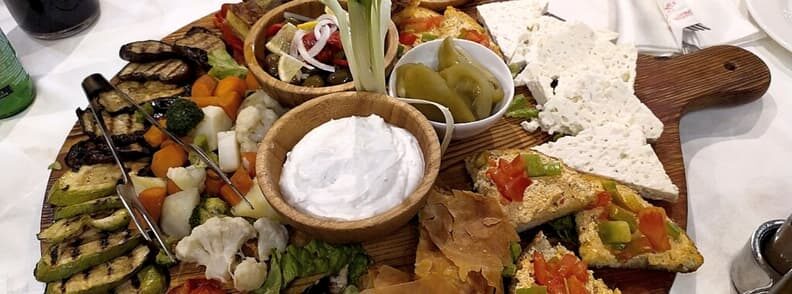
Where to eat in Berat Albania
Antigoni
The perfect place if you’re looking for a more formal restaurant. Enjoy traditional Albanian food (including stuffed vine leaves, eggplants, or peppers) as you admire the beautiful view over the Mangalemi historical neighborhood.
Antigoni Gorica is popular with locals and tourists alike.
Onufri Restaurant
You’ll find the Onufri Restaurant in the castle of Berat Albania, on the way to the Onufri Museum. Go to this Albanian restaurant to serve yourself from huge buffets of classic delicacies in a warm and inviting ambiance.
Restaurant Bar Cųci
Cųci is the greatest spot in Berat Albania for authentic meals including paçe (sheep’s head soup), veal brains, and lamb’s liver. Their menu also includes less risky but nevertheless delicious options: grilled and baked meats, kofta, pilaf, and salads.
Restaurant Bar Cųci offers great value for money in Berati’s center.
WilDor
Besides the pizza and salads you’ll find everywhere, you’ll be pleased to find less common dishes from the Albanian cuisine at this unusual restaurant. Try their mish çomlek and make sure you check out their excellent local wine list.
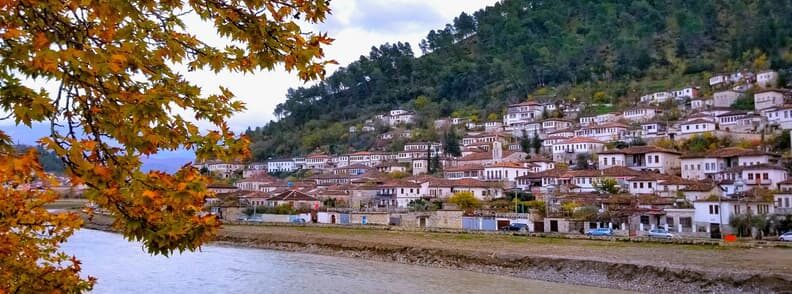
Where to stay in Berat Albania
If your trip to Berat Albania lasts longer than a day, you should book your accommodation in advance for your stay. Here are some of the best hotels to check availability:
Oda Tomori
Oda Tomori, located in Berat Albania, has a bar, common lounge, garden, and free WiFi throughout the hotel. This facility has family rooms as well as a patio for visitors. Views of the garden are available to guests.
Every room has a closet and a flat-screen TV. The private bathroom has a bidet, bathrobes, and slippers. Air conditioning and a desk are standard in all Oda Tomori flats.
Oda Tomori hotel has a daily breakfast buffet.
Colombo Hotel
Hotel Colombo in Berat Albania has 5-star accommodations with a bar, a garden, and a patio. This motel has a restaurant, a 24-hour front desk, and room service, as well as free WiFi throughout the property. There is free private parking available, as well as a chargeable airport shuttle service.
Air conditioning, a seating area, a flat-screen TV with satellite channels, a safety deposit box, and a private bathroom with a shower, slippers, and a hairdryer are all included in the hotel rooms. The rooms at Hotel Colombo contain bed linen and towels.
Each morning, the hotel provides continental and buffet breakfast selections.
Castle Park
All of the rooms at Castle Park feature air conditioning and a balcony. The property, which is located on the outskirts of a forest, has views of Tomori Mountain and the city of Berat Albania.
The rooms also include a private bathroom, cable TV, a refrigerator, and parquet flooring. Some lodging is provided in isolated lodges with private entrances.
The à-la-carte restaurant in Castle Park provides traditional Albanian and Italian food. Food and beverages are served in the medieval-themed dining hall or on the patio. Special diet options are available upon request.
Horseback riding, hiking, and cave exploration are all available in Castle Park, together with excursions to the Cobo Winery and the city of Berat Albania.
Hotel Berati
Hotel Berati is located in Berati’s historical center, within a few minutes walk from all significant sights. It has a restaurant and bar that provides conventional meals, as well as free Wi-Fi and parking.
Rooms are air-conditioned and furnished simply, with satellite TV and a wardrobe. A shower is provided in the private bathroom. On-demand laundry and dry cleaning services are offered.
Hotel Gega
Hotel Gega, located in Berat Albania, has a bar and a communal lounge. This motel has a restaurant, a 24-hour front desk, and room service, as well as free WiFi throughout the property. There is free private parking and a chargeable airport shuttle service is available.
Each room at the hotel includes air conditioning, a seating area, a flat-screen TV with satellite channels, a safety deposit box, and a private bathroom with a bidet, bathrobes, and slippers. A desk and a kettle will be provided in each guest room.
A continental breakfast is available to Hotel Gega guests.
Berat Albania guide also available on GPSmyCity.

Mirela Letailleur is a Romanian travel blogger living in the South of France. She writes on The Travel Bunny travel blog about affordable travel in Europe. Creator of unique free travel guides and local travel expert. Problem solver. Wannabe coffee guru.
After your Berat Albania vacation, check out
Visit Berat Albania: a short travel guide
Tirana Albania’s colorful and creative capital

